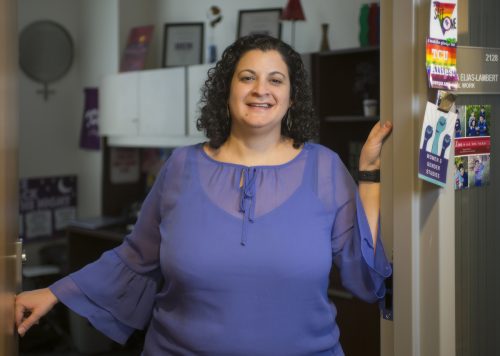
Illustration by Getty Images ©SERAZETDINOV ©ARTHOBBIT
Steps for Bystander Intervention
A social work scholar studies how to train faculty to recognize risky behavior and speak up.
Nada Elias-Lambert wants to prevent another tragedy like what reportedly happened to Kitty Genovese more than 50 years ago.
The 28-year-old woman’s murder in New York City prompted social work researchers to ask why none of the almost 40 witnesses intervened. (The initial New York Times report has come under scrutiny, but the 1964 crime remains a seminal case in studies on bystander intervention.)
Elias-Lambert, associate professor of social work and director of the Master of Social Work program, studies how best to train faculty to become effective bystanders who are prepared to intervene in violent situations. Her research focuses on methods of improving intervention training for faculty and understanding why her colleagues want to learn these skills.
Faculty members can be key in preventing violence in university settings, Elias-Lambert said. The research is timely, as reports of campus sexual assaults are on the rise nationwide. In fall 2017, the U.S. Department of Education was investigating about 350 cases of sexual violence on college campuses.
As coordinator of the faculty bystander intervention program at the Koehler Center for Instruction, Innovation and Engagement, Elias-Lambert puts research into action by teaching her peers how to avert potentially dangerous situations on campus. The center strategizes with professors to improve overall classroom experience.
The training involves two workshops, each about two hours. The first one provides an overview of intervention strategies, known as the five bystander steps, as well as a review of reporting guidelines at the federal and state levels. The second session trains faculty members to lead workshops in their departments by using language that colleagues within their disciplines will understand. (All TCU employees complete unrelated training on reporting guidelines through Human Resources.)

Nada Elias-Lambert, associate professor of social work and director of the Master of Social Work program, trains faculty to intervene in potentially risky situations. Photo by Robert W. Hart
“I might present it in a way social workers get it,” Elias-Lambert said. “But would an engineer get it?”
The researcher also is conducting follow-up surveys to examine faculty motives for attending. “Faculty members are usually extremely busy. This doesn’t fit very cleanly anywhere for them, yet it’s a decent time commitment. And there is risk involved,” Elias-Lambert said. “You are presenting to colleagues about a topic it is not easy to talk about. If [we] are going to recruit faculty to participate, I want to see how we can continue to engage faculty.”
Specializing in intervention strategies also means tackling misperceptions about what it means to intervene in the first place. “We initially think, ‘I have to put myself in harm’s way in order to change the situation.’ That’s not true at all,” Elias-Lambert said. “We can talk about the direct and indirect ways to be a bystander. So, if I see someone having an altercation and say, ‘Hey, do I know you?’ or ‘Hey, where’s the library?’ I don’t have to insert myself, but it can change the course of the [situation].”
We can talk about the direct and indirect ways to be a bystander. So, if I see someone having an altercation and say, ‘Hey, do I know you?’ or ‘Hey, where’s the library?’ I don’t have to insert myself, but it can change the course of the [situation].
Nada Elias-Lambert
Learning which aspects of faculty intervention training are most effective and measuring the effect on campus violence could have far-reaching effects, said Beverly Black, a fellow social work scholar.
“This research is sorely needed and promises to offer important information. Colleges and universities around the country will undoubtedly be eager to examine her findings,” Black, the Jillian Michelle Smith Professor in Family Violence Research at the University of Texas at Arlington School of Social Work, wrote in an email.
As faculty members learn intervention strategies, they can apply the skills to confront a multitude of risky situations, Elias-Lambert said. “The nice thing is once you know the research skill set, it can apply to racism, heterosexism and academic misconduct. If you see a student in class cheating on an exam, might you want to say something? How might you want to handle it? The skills are the same across any of these risky situations or behaviors.”

Your comments are welcome
Comments
Related reading:
Alumni, Features
Asylum-Seekers Find Solace in DASH Network
The Dallas-Fort Worth nonprofit provides housing as well as support and friendship for people fleeing persecution.
Alumni
Skip Hollandsworth’s Texas Tales: From Closets to Crime
Skip Hollandsworth, in his nearly 30 years of writing, has chronicled the best and worst of the Lone Star State.
Campus News: Alma Matters, Research + Discovery
Concussion Management and College Football
Could fish oil alleviate the effects of head trauma? TCU researchers work with the football program to investigate the neurological protections of omega-3 fatty acids.